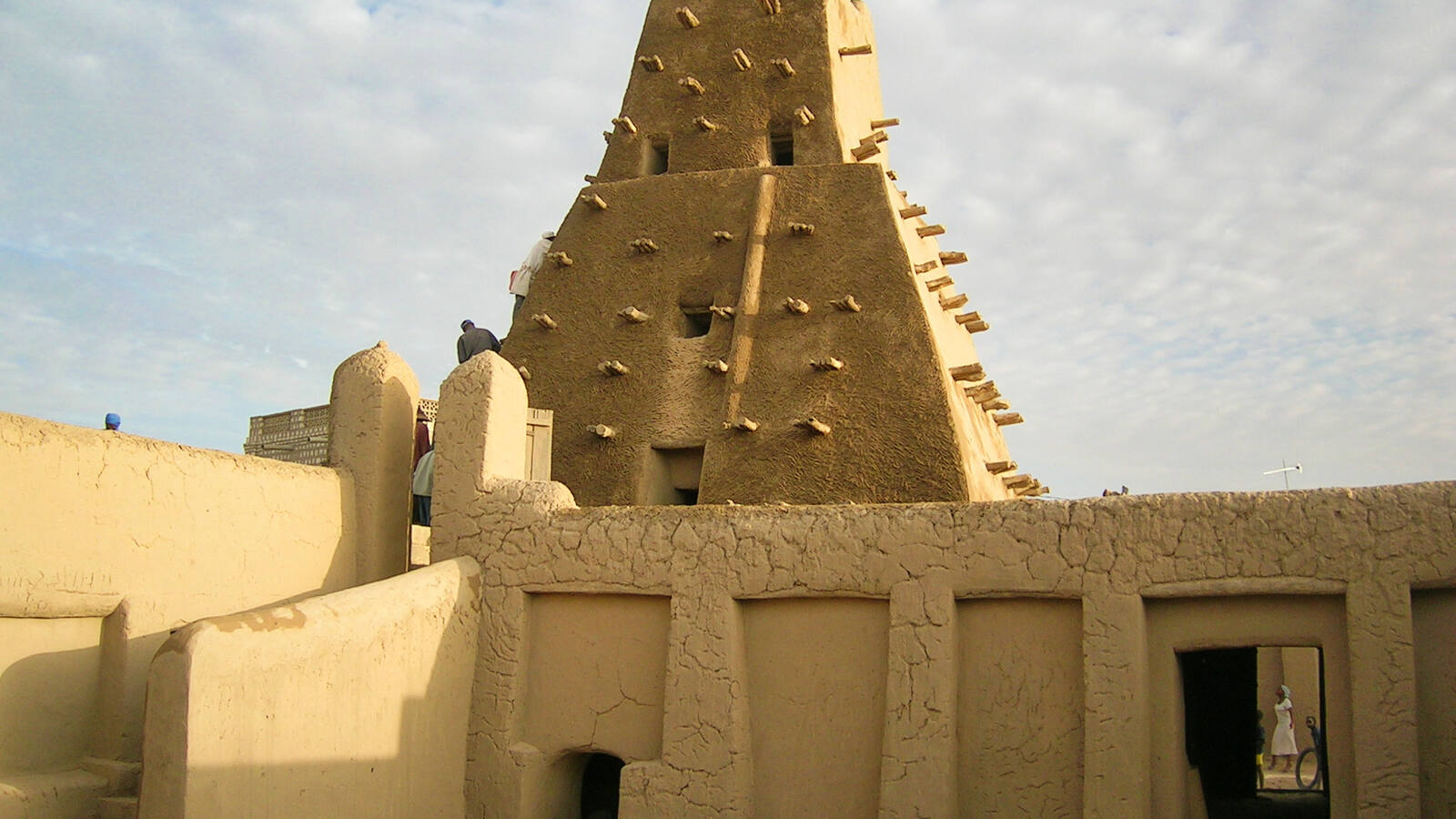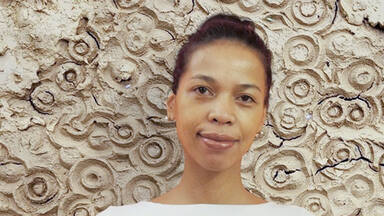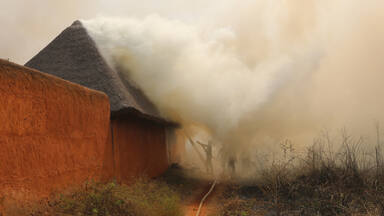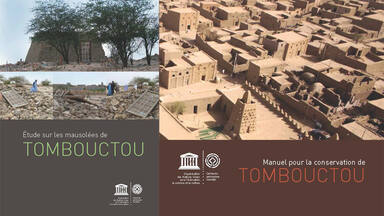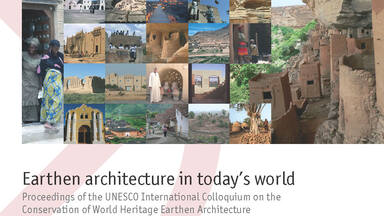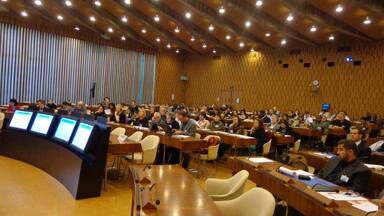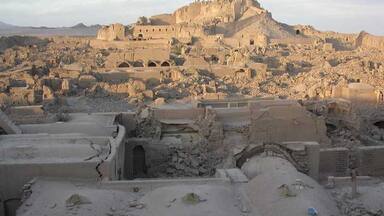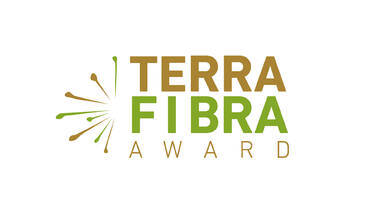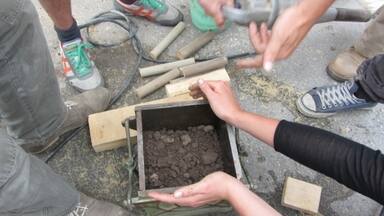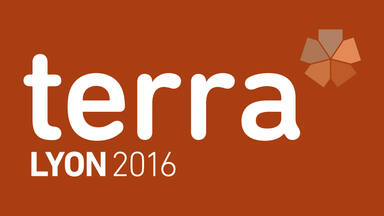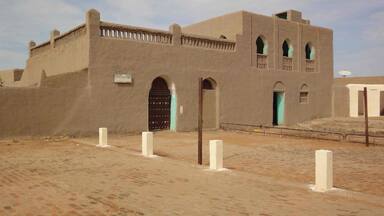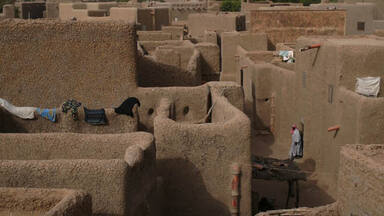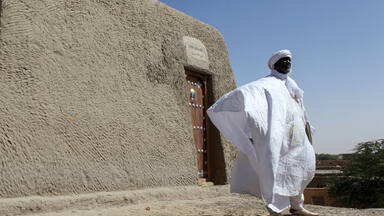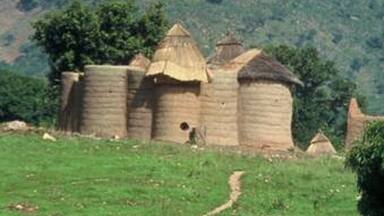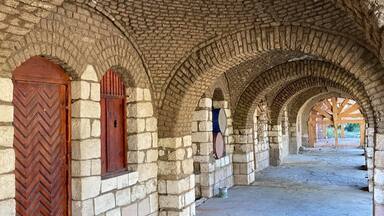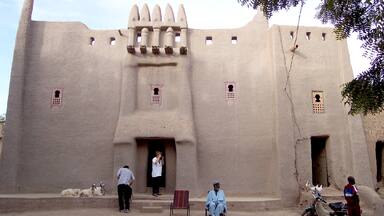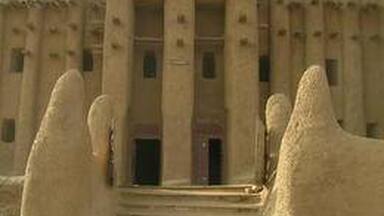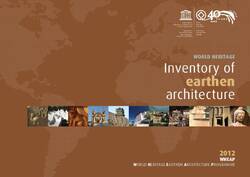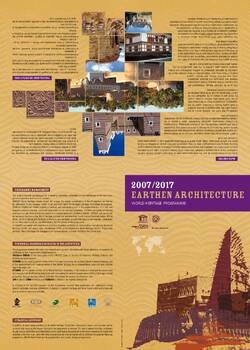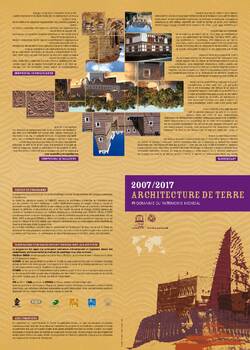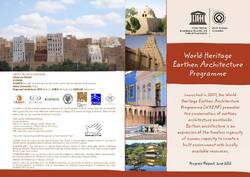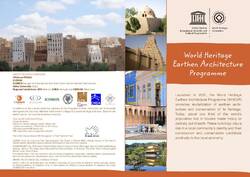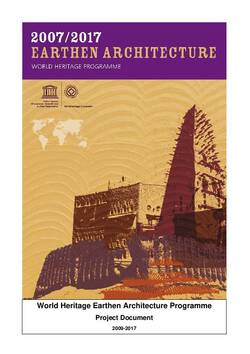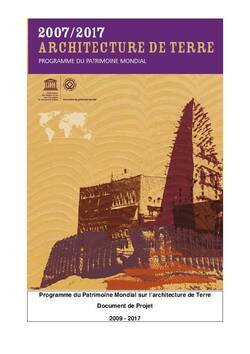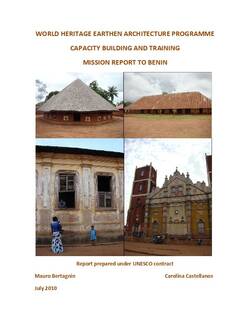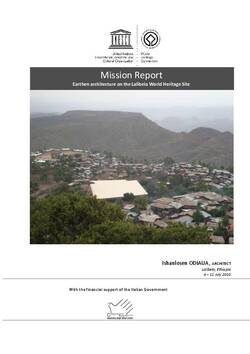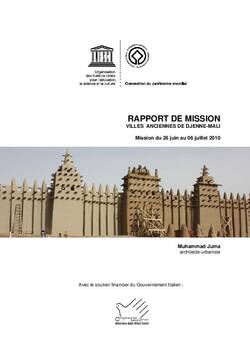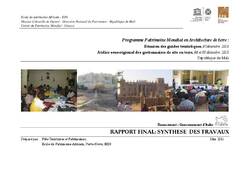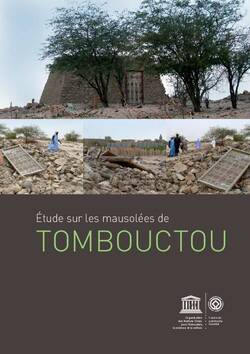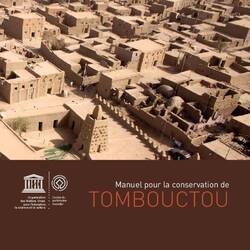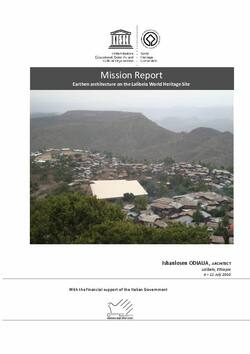Earthen architecture is one of the most original and powerful expressions of our ability to create a built environment with readily available resources.
It includes a great variety of structures, ranging from mosques, palaces and granaries, to historic city centres, cultural landscapes and archaeological sites. Its cultural importance throughout the world is evident and has led to its consideration as a common heritage of humankind, therefore deserving protection and conservation by the international community. In 2011, over 10% of the World Heritage properties incorporate earthen structures. The availability and economic quality of the material mean it bears great potential to contribute to poverty alleviation and sustainable development.
However, increasingly threatened by natural and human impacts (e.g. floods and earthquakes, industrialization, urbanization, modern building technologies, disappearance of traditional conservation practices, etc.) earthen structures deserve particular attention in terms of conservation and maintenance; about ¼ of the sites inscribed on the World Heritage List in Danger are earthen sites.
The World Heritage Programme on Earthen Architecture (WHEAP) aims for the improvement of the state of conservation and management of earthen architecture sites worldwide. Pilot projects on earthen architectural sites inscribed on the World Heritage List, or included in States Parties’ Tentative Lists, will help identify best practices and set examples for the development and dissemination of appropriate methods and techniques in conservation, management, and capacity building. Scientific research will further the endeavor to ameliorate know-how in the field. Expected results include a better understanding of the problems facing earthen architecture, the development of policies favoring its conservation, the definition of practical guidelines and the organization of training and awareness activities, particularly in local communities through workshops, exhibitions, conferences and technical publications to raise the recognition of earthen architecture, as well as the creation of an active global network for the exchange of information and experience.
At its 31st session (New Zealand, 2007), the World Heritage Committee approved the initiation of the integrated World Heritage Programme on Earthen Architecture (2007-2017) (decision 31 COM 21C, working document 31 COM 21C). Donors and States Parties were invited to provide financial support for the implementation of the activities, structured in four phases and progressively expanding over the globe. Accordingly, the preparatory phase concluded in 2008, is followed by three phases, each focusing on two regions or sub regions: Phase 2 (2009-2011) focuses on Africa and the Arab States, Phase 3 (2012-2014) on Latin-America and Central Asia, and Phase 4 (2015-2017) on Europe and Asia.
Phase 1 (2007-2008)
saw the following activities implemented
- A consultation meeting of renowned international experts in earthen architecture conservation was held in November 2007 at UNESCO Headquarters, and developed final substantial orientations for the operational framework and the programme strategy.
- The World Heritage Earthen Architecture Programme (WHEAP) was officially launched on the occasion of Terra 2008, the 10th International Conference on the Study and Conservation of Earthen Architecture (1-5 February 2008, Bamako, Mali), organized by the Getty Conservation Institute and the Ministry of Culture of Mali.
- Launching of the Inventory project of the earthen architecture sites (supported by the France-UNESCO Cooperation Agreement) (ongoing)
Phase 2 (2009-2011)
included a series of activities in Africa and Arab States
Africa
- The four-years Conservation Project for Africa (2008-2012), achieved a range of activities at earthen World Heritage sites in Africa e.g.: study on the traditional earthen buildings for the sustainable conservation of the Rock-Hewn Churches of Lalibela, in Ethiopia; development of a draft building regulations for the Old Towns of Djenné and Timbuktu, in Mali; Rehabilitation and Revitalization of the Youth House of Djenné, in Mali, including the publication of illustrated technical specifications; Regional site managers workshop and tourist guides meeting; Development of didactic material for the regional training institutions EPA (School of African Heritage, Porto Novo, Benin). and CHDA (Centre for Heritage Development in Africa, Kenya) (supported by the Italian Funds-in-Trust).
Arab states
- UNESCO Consultation Meeting on the Implementation of the World Heritage Earthen Architecture Programme (WHEAP) in the Arab States - Strategies and Approaches (11 January 2010) (supported by the private joint initiative Shaikh Ebrahim Bin Mohammad Al-Kalifa Centre for Culture and Research/ARCAPITA Bank B.S.C from Bahrain).
- The Safeguarding Project of Hassan Fathy's New Gourna Village, in Egypt (financed through the Special account for the Safeguarding of the Cultural Heritage of Egypt).
Phase 3 (2012-2014)
Latin-America and Central Asia
- Launching of Phase 3 at Terra 2012, 11th International Conference on the Study and Conservation of Earthen Architecture Heritage (22-27 April 2012, Lima, Peru)
- Strategic planning with the UNESCO Category II Centre Lúcio Costa in Brazil for implementation of the programme in the region (2011)
- Workshop on Earthen Artisans in Latin America and the Caribbean in Tlaxcala, Mexico (2009, supported by the Spanish Funds-in-Trust).
Other regions
- The 1st Mediterranean Conference on Earth Architecture, Mediterra 2009 under the aegis of UNESCO World Heritage Centre, ICCROM, ICOMOS-ISCEAH International Scientific Committee on Earthen Architectural Heritage and the Getty Conservation Institute, (13-16 March 2009).
- Restoration Project for Bam and its Cultural Landscape (supported the Italian Funds-in-Trust).
The WHEAP involves the technical support of the main international conservation institutions: the International Centre for the Study of the Preservation and Restoration of Cultural Property (ICCROM), the International Council on Monuments and Sites (ICOMOS), and the earth conservation institute CRAterre-ENSAG as well as of the regional institutions School of African Heritage (EPA, Benin), Centre for Heritage development in Africa (CHDA, Kenya), and Centre for Conservation and Restoration of Atlas and Subatlas Architectural Heritage (CERKAS, Morocco).In 2009, Udine University (Italy) also became a programme partner. In the course of the activities, the programme seeks further cooperation and partnerships with other specialized institutions, as well as national and local governmental authorities.
The programme activities are made possible thanks to the financial support granted by the World Heritage Committee through the World Heritage Fund, the UNESCO Special account for the safeguarding of the Cultural Heritage of Egypt, the France-UNESCO Cooperation Agreement, the Italian Funds-in-Trust, the Spanish Funds-in-Trust, and the Shaikh Ebrahim Mohammad Al-Kalifa Centre for Culture and Research/ARCAPITA Bank B.S.C from Bahrain.
Global TERRAFIBRA Award
in Contemporary Earthen and
Plane Fibre-based Architectures
The opening of applications for the third edition of the Global TERRAFIBRA Award in Contemporary Earthen and Plane Fibre-based Architectures took place on 3 November 2020, up until 3 Mars 2021.
This award promotes the mix of materials in contemporary architecture and aims to highlight the most innovative constructions in this division. Open to new or renovated buildings on all continents, with a significant amount of soil and/or plant fibers, this award is comprised of 10 categories, and in September 2021, the honorary jury will choose a winning project in each category.
For more information, please visit the dedicated webpage:
Documents
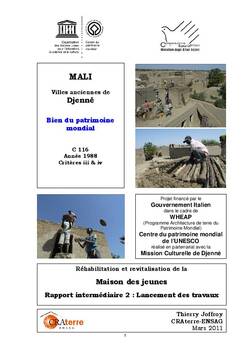 09b - Réhabilitation et revitalisation de la Maison des jeunes de Djenné : rapport intermédiaire 2°, mars 2011 .pdf
09b - Réhabilitation et revitalisation de la Maison des jeunes de Djenné : rapport intermédiaire 2°, mars 2011 .pdf
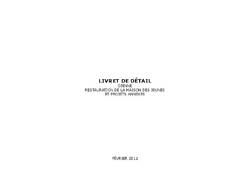 10 - Réhabilitation et revitalisation de la Maison des jeunes de Djenné : LIVRET de détail, février 2011 .pdf
10 - Réhabilitation et revitalisation de la Maison des jeunes de Djenné : LIVRET de détail, février 2011 .pdf
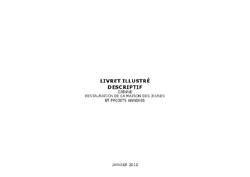 11 - Réhabilitation et revitalisation de la Maison des jeunes de Djenné : LIVRET des plans, janvier 2011 .pdf
11 - Réhabilitation et revitalisation de la Maison des jeunes de Djenné : LIVRET des plans, janvier 2011 .pdf
 12 - Réhabilitation et revitalisation de la Maison des jeunes de Djenné : rapport de la mission de démarrage, juillet 2010 .pdf
12 - Réhabilitation et revitalisation de la Maison des jeunes de Djenné : rapport de la mission de démarrage, juillet 2010 .pdf
Decisions / Resolutions (2)
The World Heritage Committee,
- Having examined Document WHC/18/42.COM/5A,
- Recalling Decision 41 COM 5A adopted at its 41st session (Krakow, 2017) and Decision 40 COM 5D adopted at its 40th session (Istanbul/UNESCO, 2016),
General: - Takes note with appreciation of the activities undertaken by the World Heritage Centre over the past year in pursuit of the Expected Result to ensure that “tangible heritage is identified, protected, monitored and sustainably managed by Member States, in particular through the effective implementation of the 1972 Convention”, and the five strategic objectives as presented in Document WHC/18/42.COM/5A;
- Welcomes the proactive role of the Secretariat for enhancing synergies between the World Heritage Convention and the other Culture and Biodiversity-related Conventions, particularly the integration of relevant synergies aspects in the revised Periodic Reporting Format and the launch of a synergy-related web page on the Centre’s website;
- Also welcomes the increased collaboration among the Biodiversity-related Conventions through the Biodiversity Liaison Group and focused activities, including workshops, joint statements and awareness-raising;
- Takes note of the Thematic studies on the recognition of associative values using World Heritage criterion (vi) and on interpretation of sites of memory, funded respectively by Germany and the Republic of Korea and encourages all States Parties to take on board their findings and recommendations, in the framework of the identification of sites, as well as management and interpretation of World Heritage properties;
- Noting the discussion paper by ICOMOS on Evaluations of World Heritage Nominations related to Sites Associated with Memories of Recent Conflicts, decides to convene an Expert Meeting on sites associated with memories of recent conflicts to allow for both philosophical and practical reflections on the nature of memorialization, the value of evolving memories, the inter-relationship between material and immaterial attributes in relation to memory, and the issue of stakeholder consultation; and to develop guidance on whether and how these sites might relate to the purpose and scope of the World Heritage Convention, provided that extra-budgetary funding is available and invites the States Parties to contribute financially to this end;
- Also invites the States Parties to support the activities carried out by the World Heritage Centre for the implementation of the Convention;
- Requests the World Heritage Centre to present, at its 43rd session, a report on its activities.
Thematic Programmes: - Welcomes the progress report on the implementation of the World Heritage Thematic Programmes and Initiatives, notes their important contribution towards implementation of the Global Strategy for representative World Heritage List, and thanks all States Parties, donors and other organizations for having contributed to achieving their objectives;
- Acknowledges the results achieved by the World Heritage Cities Programme and calls States Parties and other stakeholders to provide human and financial resources ensuring the continuation of this Programme in view of its crucial importance for the conservation of the urban heritage inscribed on the World Heritage List, for the implementation of the Recommendation on the Historic Urban Landscape and its contribution to achieving the 2030 Sustainable Development Goals related to cities as well as for its contribution to the preparation of the New Urban Agenda, and further thanks to China and Croatia for their support for the implementation of the Programme;
- Also acknowledges the results achieved of the World Heritage Marine Programme, also thanks Flanders, France and the Annenberg Foundation for their support, notes the increased focus of the Programme on a global managers network, climate change adaptation strategies and sustainable fisheries, and invites States Parties, the World Heritage Centre and other stakeholders to continue to provide human and financial resources to support for the implementation of the Programme;
- Further acknowledges the results achieved in the implementation of the World Heritage Sustainable Tourism Programme, in particular the development of the Sustainable Tourism and Visitor Management Assessment tool and encourages States Parties to participate in the pilot testing of the tool, expresses appreciation for the funding provided by the European Commission and further thanks the Republic of Korea, Norway, and Seabourn Cruise Line for their support in the implementation of the Programme’’s activities;
- Further notes the progress in the implementation of the Small Island Developing States Programme, its importance for a representative, credible and balanced World Heritage List and building capacity of site managers and stakeholders to implement the World Heritage Convention, thanks furthermore Japan and the Netherlands for their support as well as the International Centre on Space Technology for Natural and Cultural Heritage (HIST) and the World Heritage Institute of Training & Research for the Asia & the Pacific Region (WHITRAP) as Category 2 Centres for their technical and financial supports and also requests the States Parties and other stakeholders to continue to provide human, financial and technical resources for the implementation of the Programme;
- Takes note of the activities implemented jointly by the International Astronomical Union (IAU) and ICOMOS under the institutional guidance of the World Heritage Centre, in line with its Decision 40 COM 5D, further requests the World Heritage Centre to disseminate among the States Parties the second volume of the IAU/ICOMOS Thematic Study on Astronomical Heritage and renames this initiative as Initiative on Heritage of Astronomy, Science and Technology;
- Also takes note of the progress report on the Initiative on Heritage of Religious Interest, endorses the recommendations of the Thematic Expert Consultation meetings focused on Mediterranean and South-Eastern Europe (UNESCO, 2016), Asia-Pacific (Thailand, 2017) and Eastern Europe (Armenia, 2018), thanks the States Parties for their generous contribution and reiterates its invitation to States Parties and other stakeholders to continue to support this Initiative, as well as its associated Marketplace projects developed by the World Heritage Centre;
- Takes note of the activities implemented by CRATerre in the framework of the World Heritage Earthen Architecture Programme, under the overall institutional guidance of the World Heritage Centre, and of the lines of action proposed for the future, if funding is available;
- Invites States Parties, international organizations and donors to contribute financially to the Thematic Programmes and Initiatives as the implementation of thematic priorities is no longer feasible without extra-budgetary funding;
- Requests furthermore the World Heritage Centre to submit an updated result-based report on Thematic Programmes and Initiatives, under Item 5A: Report of the World Heritage Centre on its activities, for examination by the World Heritage Committee at its 44th session in 2020.
The World Heritage Committee,
- Having examined Document WHC-07/31.COM/21C,
- Welcomes the proposal to implement an integrated programme of activities in support of earthen architectural heritage and recognizes the potential of this programme to contribute towards the sustainable development of traditional settlements which could provide considerable benefits to local communities;
- Decides to allocate USD 80,000 from the World Heritage Fund as seed money for the implementation of Phase 1 of the Programme (namely, USD 40,000 from the 2006-2007 budget, and USD 40,000 from the 2008-2009 budget);
- Encourages the World Heritage Centre to seek extra budgetary funds for the implementation of the proposed Programme activities;
- Also encourages the World Heritage Centre to use local institutions and human capacity already developed in the regions to drive the programme;
- Further encourages the World Heritage Centre to ensure the transfer of management of the programme to the regions within the first four years of the commencement of the programme; for Africa however the management of the programme should be done from the region by the School of African Heritage (EPA) and the Center for Heritage Development in Africa (CHDA), as well as established heritage institutions, with advice from CRATerre-ENSAG, ICCROM and ICOMOS;
- Calls for potential donors and States Parties to provide financial support for the implementation of Programme activities;
- Requests the Director of the World Heritage Centre to prepare a report on the programme objectives and a costed multi-year programme for examination by the World Heritage Committee at its 33rd session in 2009.
